-
Posts
461 -
Joined
-
Last visited
Content Type
Profiles
Forums
Blogs
Gallery
Events
Store
Posts posted by johnnymac
-
-
Jim,
All good points regarding these clasps, letter styles and catalogue listings. What would help is if anyone has a copy of these old catalogues to post some pics.
The journey on attempting to identify all these clasp varieties continues.
Regards,
Rob
Rob,
I do agree with all that you said.
Regards Jim
0 -
Hello Jim,
Thanks for the detailed reply.
I would clarify different areas separately.
* BBB clasp. Discussions I have had with other US collectors have indicated that some BBB items were also not marked on the reverse.
In Alexander Laslo's Vic book, 2nd Edition, he specifically mentions a BB&B clasp of the same design as the DEFENSIVE SECTOR clasp shown. There is illustrated an 'Army Of Occupation' clasp on page 119, that is the same and in the text below it indicates that said Army Of Occupation clasp was manufactured by BB&B, and appeared in George Studleys catalogue of 1939. Timo's post above helpfully shows a later catalogue of the same list.
I would assume that Alexander Laslo had some good and conclusive information to suggest such a link between the clasp design and the firm of BB&B. If other US collectors have information to suggest otherwise it would be helpful to share it here as well.
I have attached a picture of a clasp, 'Army Of Occupation' that is the same as that illustrated in Alexander Laslo's book.
You mention that you have spoken to other BB&B collectors. It would be good to receive their input as, apart from yourself and Tim B, there are not that many other regular US posters on this particular thread. The more the merrier and it may help us all out.
* Split brooch. It has been indicated to me that the Split Brooch is of US production that was used on period manufacture pre-world war 2 US medals. The earlier version being the split wrap brooch with stocks of the other variety, being the Full Wrap brooch, running out sometime in the early 1940s. Is this correct??
Regards,
Rob
0 -
Hello Jim,
Thanks for the detailed reply.
I would clarify different areas separately.
* BBB clasp. Discussions I have had with other US collectors have indicated that some BBB items were also not marked on the reverse.
In Alexander Laslo's Vic book, 2nd Edition, he specifically mentions a BB&B clasp of the same design as the DEFENSIVE SECTOR clasp shown. There is illustrated an 'Army Of Occupation' clasp on page 119, that is the same and in the text below it indicates that said Army Of Occupation clasp was manufactured by BB&B, and appeared in George Studleys catalogue of 1939. Timo's post above helpfully shows a later catalogue of the same list.
I would assume that Alexander Laslo had some good and conclusive information to suggest such a link between the clasp design and the firm of BB&B. If other US collectors have information to suggest otherwise it would be helpful to share it here as well.
I have attached a picture of a clasp, 'Army Of Occupation' that is the same as that illustrated in Alexander Laslo's book.
You mention that you have spoken to other BB&B collectors. It would be good to receive their input as, apart from yourself and Tim B, there are not that many other regular US posters on this particular thread. The more the merrier and it may help us all out.
* Split brooch. It has been indicated to me that the Split Brooch is of US production that was used on period manufacture pre-world war 2 US medals. The earlier version being the split wrap brooch with stocks of the other variety, being the Full Wrap brooch, running out sometime in the early 1940s. Is this correct??
Regards,
Rob
Also note that Stubley's "Army of Occupation" and"Defensive Sector" clasps in my illustration are identical to his "Serbia" clasp. It is not anything like the one in Laslo's illustration on page 119 of Laslo's book.
See my illustration of what I think are Art Medal Works Inc. clasps.
The letter style of the two clasps, that you believe to be BB&B, are identical to the letter style used by "Art Medal Works Inc." for their Navy clasps.
Please read in A. Laslo's book on page 93, paragraph 1 & 2. Alexander Laslo states that the Jos. Mayer's had a illustrated catalog 1933, but he does not mention that there was an "illustrated" catalog in the case of Geo. Stubley.
Regards, Jim
0 -
Hello Jim,
Thanks for the detailed reply.
I would clarify different areas separately.
* BBB clasp. Discussions I have had with other US collectors have indicated that some BBB items were also not marked on the reverse.
In Alexander Laslo's Vic book, 2nd Edition, he specifically mentions a BB&B clasp of the same design as the DEFENSIVE SECTOR clasp shown. There is illustrated an 'Army Of Occupation' clasp on page 119, that is the same and in the text below it indicates that said Army Of Occupation clasp was manufactured by BB&B, and appeared in George Studleys catalogue of 1939. Timo's post above helpfully shows a later catalogue of the same list.
I would assume that Alexander Laslo had some good and conclusive information to suggest such a link between the clasp design and the firm of BB&B. If other US collectors have information to suggest otherwise it would be helpful to share it here as well.
I have attached a picture of a clasp, 'Army Of Occupation' that is the same as that illustrated in Alexander Laslo's book.
You mention that you have spoken to other BB&B collectors. It would be good to receive their input as, apart from yourself and Tim B, there are not that many other regular US posters on this particular thread. The more the merrier and it may help us all out.
* Split brooch. It has been indicated to me that the Split Brooch is of US production that was used on period manufacture pre-world war 2 US medals. The earlier version being the split wrap brooch with stocks of the other variety, being the Full Wrap brooch, running out sometime in the early 1940s. Is this correct??
Regards,
Rob
Rob,
Within a 150 mile radius of me, there are at least 12military collector shows a year. They house between 200 to 800 tables. I attend only the two largest because mostitems are a repeat. Most of the dealersknow my interest, so I find two shows a decent number. The BB&B pilot wing & badgecollectors are there.
You referenced in Laslo's bookThe "Army of Occupation" being a BB&B and sold by Stubley in hiscatalog. In Tim's illustration of Stubley's catalog, there is no mention of BB&B and no photos to show how each clasp looked. Stubley does list an"Army of Occupation" and a "Defensive Sector" clasp, but he also lists a "Serbia" clasp. His "Serbia clasp" is the only one of "all" the different types of unofficial clasps of which I know.
See my illustration of George Stubley's clasps
0 -
Just some information what I saw...
Poset up by Tom Nier on the US Militaria Forum;

Yes, thanks for the posting, Tim
I have not seen this before. Tim I count 5, unofficial clasps not 4, Chateau-Thierry,Cantignety, Soission, Verdun and Serbia. Cambria is spelled wrong maybe it is a type-o as we know that it is (Cambrai),but a lot of folks might think it was Sub Chaser. Note too, that the White Sea clasp is missing in his listing, plus it is missing below with the Asiatic clasp. Studley's, I had held he started his businessin the old 20's to early 30's, and Inot sure, but I think he passed on in the 60' or 70's.
Thanks Jim
0 -
Hi Rob,
There are so many interesting things about this medal. I hope to give you my interpretation of yourmedal. Having said that, this is the type of medal that I enjoy finding myself.
You have mention again, as you have in the past, that you believe that the "DEFENSIVE SECTOR" type clasp, that is attached tothis medal, was a product of Bailey, Banks & Biddle Co. Having 23 loose clasps of this type myself,has enabled me to examine the back straps of each one. To date, I have not found one with the BB&B stamp on them. In talking to BB&B collectors and asking them if this type clasp was too small to warrant a stamp, the answer has always been "no". They have shown me items much smaller with the BB&B stamp. Again having said that, I believe as well, there still might be a BB&B connection to this clasp or maybe another type clasp I own. Since you feel so strongly that this type clasp is a BB&B, have you found the missing link like a catalog or a good photo document that can be shared and would shed some light on this subject?
The brooch on this medal is very close to the French-made repro victory medals, so could there be a connection? See my attached posting#1.
As for the missing spacer I have several that are that wayand they are an original issue. Afterfurther examination of your clasp, I have questions. Here's why:
1. On the AISNE-MARNE clasp, note that the halfmoons seem to be deeper. The clasp has more of a brass color, not like the riverside bronze of the ones above or below.
2. Looking at the letters in the AISNE-MARNE clasp, I see by your photo, the style is slightly different than the normal original issue clasps. Note that the lower bottom of the letters on this clasp seem to be missing the pyramid shape on each of these letters"A-I-N M-A-R-N" compared to the above clasp.
3. On the reverse side, the back strap for the same clasp AISNE-MARNE is much smaller inlength. It matches the same length asthe bottom one, which is the Defensive Sector clasp. Additionally, the reverse side of the half moons, match the ones on the Defensive Sector clasp. The other three clasps match each other.
As we both know the combination of clasps would make this a 42nd Division medal, or one of another other units (or a person possibly in the MTC) which were also awarded this combination.
As for WM. F. PATTEN M.D. MAJOR M.C., I am not sure, but wouldn't the correct protocol in the military be: MAJOR WM.F. PATTEN M.D. U.S.M.C.? It appears to me that the title would precede the name. For example, WM. F. PATTEN LORD RN would be LORD WM. F. PATTEN, RN. Most items use the abbreviation of U.S.M.C. because M.C. is too informal it would be like saying Navy when in fact its RoyalNavy.
I mentions this because you stated that the engraving appearsto hand stamped - Could you post a photo of the staming.
There are to two ways of looking at situation in my mind. Someone may have wanted to embellish this medal or William took thismedal to someone and had the work done himself!
Hope that my observations, bring a new way of looking atthis medal.
Regards, Jim
Hey Rob,
I just woke up, forget this part of my posting (Most items use the abbreviation of U.S.M.C. because M.C. is too informal it would be like sayingNavy when in fact its Royal Navy). I am sure, M.C. is for Medical Corps and not Marine Corps.
Could you post a photo of the stamping on this medal.
Jim
0 -
To all,
I picked up this nice US vic about 6 months ago but hadn't paid a lot of attention to it due to other competing activities. While the item is a nice clean piece it has a number of interesting points:
* The AISNE-MARNE clasp has no spacers. This is one of the varieties that were produced with no spacers.
* The DEFENSIVE SECTOR clasp is of an unofficial variety produced by the Bailey, Banks and Biddle firm.
* The unusual split suspender is of interest.
* The top four battle clasps all have a different finish and patina.
Looking at the edge I noted some markings and upon closer inspection I noted the medal had been named stamped along the left edge (as viewed). The engraving appears to be hand stamped block letters that are of the width of the medal (circa 2.5mm wide).
The medal is so named: WM. F. PATTEN M.D. MAJOR M.C.
I am aware that named US vics are more predominantly seen on US navy specimens and I haven't seen many US army vics named. While the markings in this case are sufficiently vague do any of our US members of the forum and this thread in particular have any thoughts or clues as to the identity of origin of such an individual?
Happy for all thoughts.
Regards,
Rob
Hi Rob,
There are so many interesting things about this medal. I hope to give you my interpretation of yourmedal. Having said that, this is the type of medal that I enjoy finding myself.
You have mention again, as you have in the past, that you believe that the "DEFENSIVE SECTOR" type clasp, that is attached tothis medal, was a product of Bailey, Banks & Biddle Co. Having 23 loose clasps of this type myself,has enabled me to examine the back straps of each one. To date, I have not found one with the BB&B stamp on them. In talking to BB&B collectors and asking them if this type clasp was too small to warrant a stamp, the answer has always been "no". They have shown me items much smaller with the BB&B stamp. Again having said that, I believe as well, there still might be a BB&B connection to this clasp or maybe another type clasp I own. Since you feel so strongly that this type clasp is a BB&B, have you found the missing link like a catalog or a good photo document that can be shared and would shed some light on this subject?
The brooch on this medal is very close to the French-made repro victory medals, so could there be a connection? See my attached posting#1.
As for the missing spacer I have several that are that wayand they are an original issue. Afterfurther examination of your clasp, I have questions. Here's why:
1. On the AISNE-MARNE clasp, note that the halfmoons seem to be deeper. The clasp has more of a brass color, not like the riverside bronze of the ones above or below.
2. Looking at the letters in the AISNE-MARNE clasp, I see by your photo, the style is slightly different than the normal original issue clasps. Note that the lower bottom of the letters on this clasp seem to be missing the pyramid shape on each of these letters"A-I-N M-A-R-N" compared to the above clasp.
3. On the reverse side, the back strap for the same clasp AISNE-MARNE is much smaller inlength. It matches the same length asthe bottom one, which is the Defensive Sector clasp. Additionally, the reverse side of the half moons, match the ones on the Defensive Sector clasp. The other three clasps match each other.
As we both know the combination of clasps would make this a 42nd Division medal, or one of another other units (or a person possibly in the MTC) which were also awarded this combination.
As for WM. F. PATTEN M.D. MAJOR M.C., I am not sure, but wouldn't the correct protocol in the military be: MAJOR WM.F. PATTEN M.D. U.S.M.C.? It appears to me that the title would precede the name. For example, WM. F. PATTEN LORD RN would be LORD WM. F. PATTEN, RN. Most items use the abbreviation of U.S.M.C. because M.C. is too informal it would be like saying Navy when in fact its RoyalNavy.
I mentions this because you stated that the engraving appearsto hand stamped - Could you post a photo of the staming.
There are to two ways of looking at situation in my mind. Someone may have wanted to embellish this medal or William took thismedal to someone and had the work done himself!
Hope that my observations, bring a new way of looking atthis medal.
Regards, Jim
0 -
Changing subject,
To All
I purchased on ebay a British War Medal plus a WWI, U.S. NavyVictory Medal (no clasp) for $1. and $6 S&H. I do not have connections to get information on Britishservicemen, so I am asking if someone does, will they look up LIEUT. H.H.R.VIBART.
Thank You, JM
0 -
To All
Can someone post a large and clear side by side illustrationof both the obverse and reverse sides to show the different between the Italian"Official type 1" and the Italian "Reissue type 1" sincethey both are by the same manufacturer but at different time period.
Thanks JM
0 -
Hello JM,
It is mentioned in the second edition of Mr Laslos book that 'this five-pointed star has a radius of 3mm'...
Radius is defined as:
1. a straight line extending from the centre of a circle or sphere to the circumference or surface;
2. a right line drawn or extending from the center of a circle to the periphery;
3. a straight line from the centre to the perimeter of a circle (or from the center to the surface of a sphere);
or in this case the centre to the outer edge of the star.
Sources:
1. The Macquarie Dictionary, 2nd Ed 1991
2. New Oxford American Dictionary, 2nd Ed 2005
2. The Collaborative International Dictionary of English v.0.48
3. WordNet ® 2.0
4. www.dict.org
That would be measured from the centre of the star to the outside edge of the points. A total of 6mm would be derived from an edge to edge measurement at its widest points. This of course doesn't take into account minor manufacturing differences. I believe that would be more consistent than a 3mm star.
Regards,
Rob
Hello Rob
Regards, JM
0 -
Tim
After enlarging Lasko's photo and seeing that the top point of his five pointed star completely covers the buckle's top cross bar which is around 3mm. Laslo's star which he illustrated is much larger then 3mm. The open area inside the buckle is 6mm+. Was there a misprint of a 3 when it should have been an 8, I do not know?
But in my illustration you see that there are 10 threads in the middle section of the buckle, it take's 4 threads to equal 3mm. I placed a star which is 3mm on the top cross bar of the buckle. See how much smaller it is than the star in Laslo's illustration?
Having said that, I agree, what we need is more information, more documentation and a good Portuguese medal collector.
(JM)
(JM)
0 -
Hi JM,
Well, I don't know but I think we need to look into it a bit more before making conclusions. The US made stars (talking the small campaign/service stars for subsequent awards) are 3/16", or approximately 4mm in size. The larger stars (decorations) are 5/16" and noticeably larger.
I believe, the correct silver star that was supposed to be used for the Portuguese Victory Medal is small in nature and IMO, probably closer to the 4mm size based on past examples I have seen PIC's of. The larger stars are just too big. So, perhaps Laslo got it correct afterall, or his measurements were off, ever-so-slightly.
So, in my opinion, the star should sit inside the buckle and not on top of it. Perhaps the tips are touching the inside edges and it may be a case of manufacturer differences, but I think some of those larger stars you showed earlier are out of place and probably added by someone after the fact, for whatever reasons. My vote is for the smaller star and until I see some verifyable source stating otherwise, the small silver star is the only authorized attachment beside the common buckle we see on many Portuguese awards.
I want to add in closing, that we see various examples throughout the European countries where servicemen have taken "artistic license" in adding unauthorized or non-regulation type attachments. Sometimes it's larger stars, gilted medals, or regimental insignia. So, who knows at this point. However, per regulations, only the small silver star is called out in the references as far as I see.
Regards,
Tim
Here's just a few case in point:

Tim
After enlarging Lasko's photo and seeing that the top point of his five pointed star completely covers the buckle's top cross bar which is around 3mm. Laslo's star which he illustrated is much larger then 3mm. The open area inside the buckle is 6mm+. Was there a misprint of a 3 when it should have been an 8, I do not know?
But in my illustration you see that there are 10 threads in the middle section of the buckle, it take's 4 threads to equal 3mm. I placed a star which is 3mm on the top cross bar of the buckle. See how much smaller it is than the star in Laslo's illustration?
Having said that, I agree, what we need is more information, more documentation and a good Portuguese medal collector.
(JM)
0 -
Hi Rob,
My main goal was to fast track it, hopefully get a Portuguese medal collector's feed back. But I see your point and I will post my next illustration to WWI Victory Medal of the World. Then there will be two places were I might get the answerer to my question.
Rob - since we all are at times working off a photo we do not get to see all the details of that piece. But don't you see any relationship to the French stars shape andsize? I do realize that most of theEuropean Official Victory medals have a back ground with either France or Czechoslovakia and I found that the relationship is also in the unofficial types.
In surfing the web I have discovered that the Portuguese medals pre 1900's and post 1920 used a oversized attachment in the center of their buckle and the device was color matched to the a attachment (Bronze tobronze, silver to silver ect). This information is from posting and photos in 2006, from the OMSA forum.
(JM)
To all interested persons, but request I have moved thisposting to "WWI Victory Medals of the World" - Page 27, posting #536
0 -
To All
I matched the two Vic's ribbons for scaling. Also in the color photo you see that the buckles are the same size.
In measuring all four cross arms (top, bottom and bothsides) of the two buckled I have, all are 3mm. The inside open area of the buckle where the device would be placed, itsmeasured at 6mm.
The original "star" in the color photo shows that its left and right top cross arms do not come close to the bottom of the buckle's cross arm, like it is shown in Laslo's photo. Knowing that the open area inside the buckle is 6mm, I would guess that the colored star is 6mm, andnot 3mm. Of course this is mostly guess work not having the medal in the color photo.
Laslo writes that the silver star is 3mm. Using his photo it can be seen that his star covers all of the middle opening (6mm) plus the top cross bar of the buckle (3mm) which put at 8-9mm. So the 3mm in his book must be a misprint.
In surfing the webb for the information on my posting I have come across at least 30 photos of Portuguese medals, some pre 1900 and some post 1920. What I found interesting was that the center devices were large and sat on top of the buckle. My thoughts only - To me, the large device is a way to prevent the buckle from slipping down the ribbon.
It is also written by Laslo that the buckle may have served as a way to secure the ribbon over a metal hanging suspension, then why have buckles in bronze, silver and gold. To me it is clearly an award since there are to many Portuguese medals with out a buckle. Plus I add this about the buckle - on the all items that had a buckle, that I have handled, one end had to be secured to the buckle. Last, there is just not enough room to double fold both sides of the ribbon through the blackstrap.
(JM)
I super-imposed a star in my photo posting just for scaling. 0
0 -
JM,
On the medal in question; when actually reviewing the piece in my hand the small star is not so shiny as it appears in your picture and has lost some of the silver finish.
Again it would be good if this discussion could be moved to the main vic thread as it contributes to that subject. Any thoughts??
Rob
Hi Rob,
My main goal was to fast track it, hopefully get a Portuguese medal collector's feed back. But I see your point and I will post my next illustration to WWI Victory Medal of the World. Then there will be two places were I might get the answerer to my question.
Rob - since we all are at times working off a photo we do not get to see all the details of that piece. But don't you see any relationship to the French stars shape andsize? I do realize that most of theEuropean Official Victory medals have a back ground with either France or Czechoslovakia and I found that the relationship is also in the unofficial types.
In surfing the web I have discovered that the Portuguese medals pre 1900's and post 1920 used a oversized attachment in the center of their buckle and the device was color matched to the a attachment (Bronze tobronze, silver to silver ect). This information is from posting and photos in 2006, from the OMSA forum.
(JM)
0 -
Hey JM,
Yes, a good example posted. If you look at the top star, you can see the star edges have flat borders, while the second star edges slope completely to the edge of the star.
When I look at the styles of stars mounted on various medals awarded by several countries during that time frame, 90% of those stars have the same basic attribute; those flat edges on borders. I'm not sure if it's a French/European thing, as French manufacturers produced a lot of the awards along with the ribbons/attachments, but the style seems pretty consistent. throughout the various countries.
On the other hand, the US made stars are of the style without the flattened borders and always have been as far as I know. I assume here, in the case of an American receiving the French CdG, those stars are of the first variety as the award was not US.
So, I would personally feel more comfortable with the top buckle/star than I would with the one below it. Maybe I am wrong here and need to see more Portuguese items or have a knowledgeable source come in, but when I see a star like the 2nd one, I automatically question whether someone added it to embellish the ribbon for combattants.
Tim
Hi Tim
Referring to my earlier posting - On the bottom vic medal which you just did a reply too, I would totally agree with you, it looks out o fplace.
Again referring to my earlier posting - On the top vic medal note how much the first medal's star matches the star used by the French.
My illustration shows a yellow box around one with three stars in it. The two stars on each end are silver and note how dull they are. All "metals" oxidize to some degree no matter how well they are kept. Yet, the photo of the star on the top of my earlier posting looks like it just came out of the box. The medal and star in question is on the bottom of my latest posting.
(JM)
0 -
Hi guys,
Just showing another example here.
I never actually measured my buckle but, it is more of a darkened or blackened bronze with a thin backstrap. Here's a PIC that I posted in the other thread on Victory Medals of the World. Ribbon appears original and is sewn such that the backstrap is concealed. Picked it up from a collector in Portugal. The buckle, in my case, is not pulling on the ribbon at all and the outside edge actually protrudes just beyond the ribbon edge. Unfortunately, this one does not have the small silver star for combattants.
I often wondered how many have had stars added overtime and would like to see close-ups of actual legitimate stars for this medal. I know the US continues to make small silver stars (3/16") for ribbons (+ 5 awards) and I have some concerns that some of these examples might actually have these type stars added for embellishment. The US style is different from the original Portuguese style though, I believe.
Tim
Hi Tim, thanks for your input, . I posted a secondmedal also with a large star from the OMAS forum site (there was no date forthis medal).
Regards JM
0 -
With regards the two pictures in your last, how can we be sure that the Police medal with clasp & star are original as a issue item?
The second picture shows the normal clasp that was common to the Portuguese victory medal however, from the front it appears not to be pulling the ribbon out of line as much as the pictures posted previous.
My understandings from reading Mr. Laslo book with regards the Portuguese Decree's concerning the Portuguese Victory medal award and Commemorative Medal of the Campaigns of the Portuguese Army, Mr. Laslo mentions:-
Decree No. 5:400 of April 12 1919 with regards the "Clasp "Batalha de La Lys, 9-IV-918" for those wounded in the Battle of Lys.
Provisions for the "FRANCA 1917 - 1918" clasp because of it being associated with the Victory Medal.
Decree No. 6:568 of 24 April 1920 :- completely revised the service criteria of Decree No. 6:186, including the provision for three month's combat service and eliminated those articles of Decree No. 6:186 pertaining to those eligible.
(Clasps:- "FRANCA 1917 -1918" or "MOCAMBIQUE 1914 - 1918." for the Commemorative Medal of the Campaigns of the Portuguese Army.)
this was later amended by Decree No. 8:993 of 17 July 1923 to include those military personnel referred to in Law No. 1:123 of 4 March 1921. (Establishment of clasps for the Commemorative Medal of the Campaigns of the Portuguese Army for service during the war in the maritime defense of the "Entrenched Camp of Lisbon" and the cities of Funchel (Madeira Islands) and Ponte Delgada (Azores).
Those clasps bear the legend:-
"C.E.L.,Defensa Maritima 1916-1918",
"Funchal, Defensa Maritima 1916-1918",
"Ponta Delgada, Defensa Maritima 1916-1918"
Decree No. 6:186 :- stipulates the design criteria. (later amended by Decree No. 7:464 of 25 April 1921.
With regards Decree No. 6:186 Mr. Laslo writes:- " as with many Portuguese medals a ribbon buckle of dull (matte) bronze was also prescribed.
The ribbon buckle appears to have no special significance and may have been primarily intended as a decorative device for securing the two halves of the suspension ribbon when folded over the French style mounting bar typically used by the Portuguese.=
Decree No. 6:186 - the names of eligible Army personnel published in Divisional orders from rolls provided by subordinate commanders, and its likely that a similar arrangement was established for Navy personnel.
So it appears Mr.Laslo had good access to the Portuguese Archives, (the same can not be said for those countries that ended up in the Eastern Block, (Czechoslovakia, Romania,) or as in the case of the Siamese / Thailand example, civil service indifference to certain information and statistics.
All we can hope for is to see some period pictures of these Portuguese clasps in wear on recognizable dated pictures of military persons or veterans.
Or a publication in English of the original Decree material from the Portuguese Archives.
Kevin in Deva.

Hello again Kevin
The medal with the one silver star which I posted was fromthe web site of OMAS Forum - 2006 Onemember posted this question: The Obverse states: Republic Portuguese, Public Safety. Reverse states: Humility, Patriotism,Dedication and Altruism 1926. This is a Police Public Safety Medal for the servicesstated on the reverse of the medal. I have been unable to find out the meaningof the star attached to the ribbon and would appreciate feedback regarding itsmeaning.
The answerer he received came from: Jorge Filipe Brandao Quinta-Nova Coleccionador de Codecoracoes Militares Portuguesas. And he replied back"According to the 1929 legislation, this is the Assiduity medal forsecurity forces, Article 15 of this regulation states the design of the decorationalways in silver and that 1silver star is for 10 yrs. service, 2 stars 20 yrs.and 3 stars for 30 yrs".
So I think someone out there thinks that this Star and itssize is official, that is why I posted it.
As for the buckle, in looking for my answerer I have seenmany buckle that were over sized, just right and slightly tight. Maybe at the time their mfg. standards werenot what they were in the U.S.A.
JM
0 -
Hello Kevin,
As we all know not all things were available to the collecting world market in 1992. Lasko's book is very much the standard we all use, but because new items turn up on the new market " the world wide web", we have to question them. That is one of the joys of collecting. Lasko's himself did a second edition on his book because there was more information to get out. You say: "DecreeNumber 6:756 of the 10th July 1920 established a silver star suspension andservice ribbon device to recognize those persons who served in combat as defined by Decree No:6186". But "do" we know for a fact that there were no other decree's ever made for the Portuguese Victory medal in the next 90 years?
Yes it could be an after market buckle and stars and if so, might be covered by the fact that many of the veterans did not get their medals from the their own government (which happen in many other countries), but they did purchased their Victory medal from private suppliers.
Maybe we will get someone who will read this posting and who can fill in the missing pieces.
(JM)
0 -
Hallo Gents,
just a thought but, was the 2 bronze star buckle originally intended for the Victory Medal?
Too my eyes it appears to be pulling the ribbon in on the right-hand side, suggesting to me it was meant for a narrower ribbon.
Is the ribbon original PortugueseIAVM ribbon or a version of the US/UK replacement ribbon?
Hopefully we can get confirmation from a Portuguese G.M.I.C. member with regards the ribbon insignia and clasps.
The "Bible" The Inter-Allied Victory Medal of World War 1 /2nd Revised edition) by the Late Alexander J. Laslo, only makes mention of the Silver Star :-
"Decree Number 6:756 of the 10th July 1920 established a silver star suspension and service ribbon device to recognise those persons who served in combat as defined by Decree No:6186.
This five-pointed star has a radius of 3mm and was to be placed in the middle of the ribbon buckle. The star is secured to the ribbon by two prongs which are pushed through the (ribbon) fabric and then bent over."
Kevin in Deva.
Hello Kevin,
As we all know not all things were available to the collecting world market in 1992. Lasko's book is very much the standard we all use, but because new items turn up on the new market " the world wide web", we have to question them. That is one of the joys of collecting. Lasko's himself did a second edition on his book because there was more information to get out. You say: "DecreeNumber 6:756 of the 10th July 1920 established a silver star suspension andservice ribbon device to recognize those persons who served in combat as defined by Decree No:6186". But "do" we know for a fact that there were no other decree's ever made for the Portuguese Victory medal in the next 90 years?
Yes it could be an after market buckle and stars and if so, might be covered by the fact that many of the veterans did not get their medals from the their own government (which happen in many other countries), but they did purchased their Victory medal from private suppliers.
Maybe we will get someone who will read this posting and who can fill in the missing pieces.
(JM)
0 -
Hi Rob, good to see you back:
I purchased this on a "buy now" the price was wellunder $50. It come from Canada and theseller stated that it was his Great Grandfather's (which all have heardbefore). But he also listed severalother WWI items, 2 badges & 1 belt buckle (all Portugal) and all at a verylow price. His feedback for items soldwas for household items and his rating was (482) for items sold. My question then is? Why have I not seen this type buckle beforeand if is a repro, and why not at least make it like the silver star one (whichis known to be good). True it wouldembellish the award but it would also leave a lot of questions. So why not do one silver star and call it aday.
The Buckle is around 37mm by 11.5mm and the stars are the typeyou bend the two pins back (The stars and buckle are not made as oneunit). The back-strap of the buckle isforced bent into the ribbon on the reverse side (possibly by the owner). Which might account for some of tightness atthe ribbon sides. As you have pointedout in the past on ribbons, there could be a slight difference betweenMfg.
Just maybe this two bronze star buckle combo was issued at alater date for reasons yet not known.
As always regards (JM)
0 -
Hello JM,
As has already been alluded to the more regularly identified star, found on the Portugal vic is much smaller and in a silver finish.
Of note is that while the particular ribbon is definitely attributable to that of Portuguese manufacture (there are many varieties of the vic ribbon directly attributable to specific countries which aids in authenticity) the ribbon buckle shown is less likely to have been original to this vic.
Ribbon buckles are commonly seen on a wide variety of Portuguese medals and in this case the ribbon buckle is significantly narrower than the accompanying ribbon. The ribbon buckles that are regularly seen on portugal vics are both narrower in width and depth but also have a more bronzed finish. They are also generally flush with the edge of the ribbon.
It is likely that such a buckle has been placed on this vic, with the larger than normal ribbon stars to embellish the award.
This information would also add to the long running general vic thread.
Regards,
Rob
Hi Rob, good to see you back:
I purchased this on a "buy now" the price was wellunder $50. It come from Canada and theseller stated that it was his Great Grandfather's (which all have heardbefore). But he also listed severalother WWI items, 2 badges & 1 belt buckle (all Portugal) and all at a verylow price. His feedback for items soldwas for household items and his rating was (482) for items sold. My question then is? Why have I not seen this type buckle beforeand if is a repro, and why not at least make it like the silver star one (whichis known to be good). True it wouldembellish the award but it would also leave a lot of questions. So why not do one silver star and call it aday.
The Buckle is around 37mm by 11.5mm and the stars are the typeyou bend the two pins back (The stars and buckle are not made as oneunit). The back-strap of the buckle isforced bent into the ribbon on the reverse side (possibly by the owner). Which might account for some of tightness atthe ribbon sides. As you have pointedout in the past on ribbons, there could be a slight difference betweenMfg.
Just maybe this two bronze star buckle combo was issued at alater date for reasons yet not known.
As always regards (JM)
0 -
-



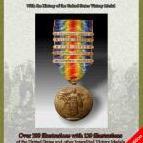
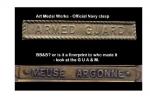

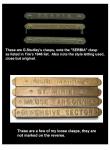
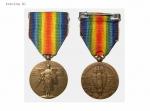
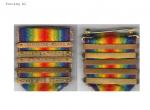

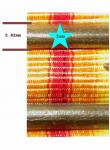
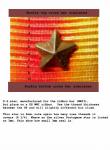
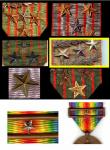

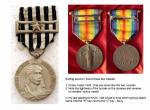

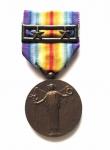
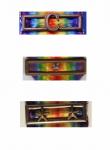
American (US) Victory Medals
in Inter-Allied Victory Medals of the Great War
Posted · Edited by johnnymac
Rob,
As far as my Serbia be marked, the answer is no. It is identical to several others of this type, some marked France on back strap and others without any mark. I have two that have the same obverse, but only one of them is marked "FRANCE". When I can get to them I will post.
This is a new purchase and is a different type clasp then Serbia grouping, but it to comes with and without marking. Two of the three back straps are marked made in France and note the height of the back strap of the unmarked one.
Regards, Jim